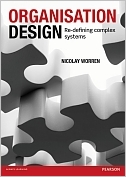| |||||
• polskie
• Zamów informacje o nowościach z wybranego tematu • kontakt |
ORGANISATION DESIGNWORREN N.wydawnictwo: PEARSON, 2012, wydanie Icena netto: Organization design is part of every manager and leader’s job: attempting to understand and improve how organizations function through creating or adjusting of roles, processes, and structures. In fact, most managers are faced with organization design challenges on an almost daily basis. Managers constantly design and redesign individual roles, define new projects (including their structure and reporting relationships), and contemplate better ways to co-ordinate organizational processes with multiple internal stakeholders. Periodically they may also make more fundamental changes to business structures, or adapt and implement high-level designs developed by others. This textbook introduces concepts and frameworks for designing complex organizations. It starts by outlining some of the key concepts that serve as a foundation to understanding how the theory applies in practice. It also reviews the status of organisation design - as a field of research and as a practical discipline - both its achievements, and some of its challenges and limitations. It then discusses how the field can develop to ensure that it provides research-based and useful knowledge that contributes to enhancing the effectiveness of organizations. Table of Contents About the author Chapter 1 Why design matters Index 288 pages, Paperback Księgarnia nie działa. Nie odpowiadamy na pytania i nie realizujemy zamówien. Do odwolania !. |


